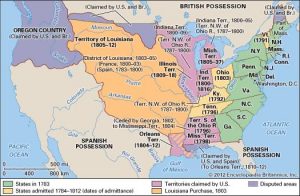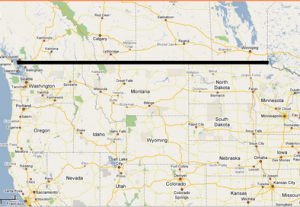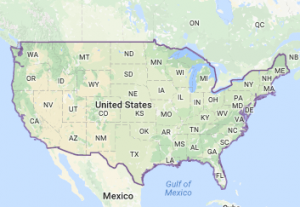 From the time the United States first declared their independence, there was a dispute over the border between the United States and its northern neighbor, Canada. In 1818, the situation finally got to a point whereby a final decision had to be made. It was determined that a convention needed to be held to handle the dispute. The convention, known as the London Convention, Anglo-American Convention of 1818, Convention of 1818, or simply the Treaty of 1818, was to discuss fisheries, boundary and the restoration of slaves between the United States of America and the United Kingdom of Great Britain and Ireland. The Treaty of 1818 was signed during the presidency of James Monroe, and it resolved the boundary between the United States and Canada, then owned by the United Kingdom, once and for all. The treaty allowed for joint occupation and settlement of the Oregon Country, known to the British and in Canadian history as the Columbia District of the Hudson’s Bay Company, and also took in New Caledonia, near Australia.
From the time the United States first declared their independence, there was a dispute over the border between the United States and its northern neighbor, Canada. In 1818, the situation finally got to a point whereby a final decision had to be made. It was determined that a convention needed to be held to handle the dispute. The convention, known as the London Convention, Anglo-American Convention of 1818, Convention of 1818, or simply the Treaty of 1818, was to discuss fisheries, boundary and the restoration of slaves between the United States of America and the United Kingdom of Great Britain and Ireland. The Treaty of 1818 was signed during the presidency of James Monroe, and it resolved the boundary between the United States and Canada, then owned by the United Kingdom, once and for all. The treaty allowed for joint occupation and settlement of the Oregon Country, known to the British and in Canadian history as the Columbia District of the Hudson’s Bay Company, and also took in New Caledonia, near Australia.

It was ultimately decided that the boundary line should be a straight one, because it would be easier to survey. The prior boundaries were based on watersheds, and were difficult to survey. The treaty marked both the United Kingdom’s last permanent major loss of territory in what is now the Continental United States and the United States’ only permanent significant cession of North American territory to a foreign power. Britain ceded all of Rupert’s Land south of the 49th parallel and west to the Rocky Mountains, including all of the Red River Colony south of that latitude, while the United States ceded the northernmost tip of the territory of Louisiana above the 49th parallel.
 Of course, the prior border from the Great Lakes to the east coast, was already established, so it isn’t straight, but the northwestern border is a straight line. I always thought that was odd, and didn’t know why it was that way. I don’t know if I was not paying attention in history class, which was not my favorite subject in my youth, although I don’t really know why it wasn’t, because now I find it quite fascinating. It’s interesting to find out that the northern border was simply a matter of convenience, and a bit of the barter system, if you will. In order to solve the border war, of sorts, Canada (United Kingdom) gave a little, and the United States gave a little. The end result was a clear cut border, and really, peaceful neighbors. I think the was a good way to settle things.
Of course, the prior border from the Great Lakes to the east coast, was already established, so it isn’t straight, but the northwestern border is a straight line. I always thought that was odd, and didn’t know why it was that way. I don’t know if I was not paying attention in history class, which was not my favorite subject in my youth, although I don’t really know why it wasn’t, because now I find it quite fascinating. It’s interesting to find out that the northern border was simply a matter of convenience, and a bit of the barter system, if you will. In order to solve the border war, of sorts, Canada (United Kingdom) gave a little, and the United States gave a little. The end result was a clear cut border, and really, peaceful neighbors. I think the was a good way to settle things.


5 Responses to 49th Parallel North